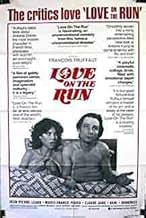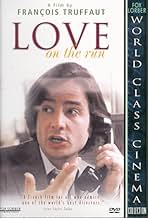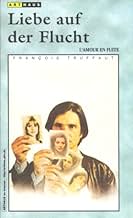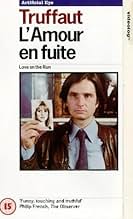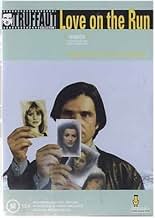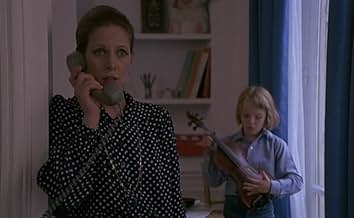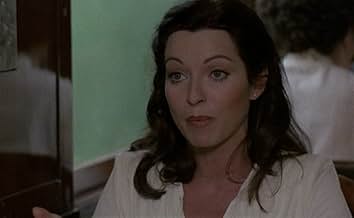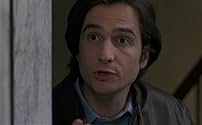VALUTAZIONE IMDb
7,0/10
7892
LA TUA VALUTAZIONE
Ora sulla trentina, Antoine Doinel ripensa al suo passato mentre la sua coppia crolla, indebolita dall'infedeltà e dalla promessa di una nuova passione.Ora sulla trentina, Antoine Doinel ripensa al suo passato mentre la sua coppia crolla, indebolita dall'infedeltà e dalla promessa di una nuova passione.Ora sulla trentina, Antoine Doinel ripensa al suo passato mentre la sua coppia crolla, indebolita dall'infedeltà e dalla promessa di una nuova passione.
- Regia
- Sceneggiatura
- Star
- Premi
- 1 vittoria e 1 candidatura in totale
Jean-Pierre Léaud
- Antoine Doinel
- (as Jean-Pierre Leaud)
Dorothée
- Sabine Barnérias
- (as Dorothee)
Recensioni in evidenza
Love on the Run (1979), the closing chapter in François Truffaut's celebrated series of films focusing on the character of Antoine Doinel; a near-iconic figure in French cinema brought vividly to life by the always great Jean-Pierre Léaud. Here, the actors injects the part with his usual nervous charm and cocky likability, though it is clear that character of Antoine is , still as uncertain about life, love and fidelity as ever before. On a Structural level, the film is built around Antoine's divorce from his wife Christine - with the reappearance of Claude Jade from Stolen Kisses (1968) and Bed and Board (1970) - inter-cut with flashbacks to early escapades from Antoine's presented in the style of a clip show.
This particular stylistic device does set up a sense of familiarity for new viewers, however; with such a slight plot, the flashbacks end up becoming the most interesting part of the movie, with what little new footage there is so repetitive that it feels like you're watching the same scene over and over again. In fact, the film is so hastily put together that it looks like Truffaut is desperate to get the series finished and out of the way, so that he can finally move on with the more progressive work that he was attempting with films like The Green Room (1979) and The Last Metro (1980).
Still, the film can sometimes be charming and the actors are all on fine form, but the whole thing seems lacking somewhat; with the use of repeated imagery and scenes cut and pasted from the previous films making this feel too much like a retread rather than a radical re-interpretation. For me, the film just seems empty, deflated and somehow lacking the allure, beauty and sophistication that was always synonymous with Truffaut's work or at least the films of his that I am familiar with. For me, Love on the Run was something of a slight, disappointing and unimaginative film that failed to inspire me in the way I had initially hoped.
This particular stylistic device does set up a sense of familiarity for new viewers, however; with such a slight plot, the flashbacks end up becoming the most interesting part of the movie, with what little new footage there is so repetitive that it feels like you're watching the same scene over and over again. In fact, the film is so hastily put together that it looks like Truffaut is desperate to get the series finished and out of the way, so that he can finally move on with the more progressive work that he was attempting with films like The Green Room (1979) and The Last Metro (1980).
Still, the film can sometimes be charming and the actors are all on fine form, but the whole thing seems lacking somewhat; with the use of repeated imagery and scenes cut and pasted from the previous films making this feel too much like a retread rather than a radical re-interpretation. For me, the film just seems empty, deflated and somehow lacking the allure, beauty and sophistication that was always synonymous with Truffaut's work or at least the films of his that I am familiar with. For me, Love on the Run was something of a slight, disappointing and unimaginative film that failed to inspire me in the way I had initially hoped.
By finding an opportunity to firmly end his cycle of films about Antoine Doinel, Francois Truffaut gave himself a great advantage by permitting this film to go to any lengths necessary as long as it concludes the series, which has essentially been represented as a number of chapters portraying the lives of one unusual Parisian man.
In The 400 Blows, Antoine struggled with finding his place in the world as an adolescent and the relationship with his parents. In Antoine and Colette he found the pitfalls associated with love, a trend that would continue in Stolen Kisses and Bed and Board. Love on the Run is brilliantly done in the way that it incorporates all of these details via flashbacks and sequences designed to remind the audience of characters seen in previous films. Truffaut carefully edits these scenes in such a way as to appear as nostalgic memories as well as to aid along the audience in understanding the reasons and consequences of these characters' actions.
Once again, this story focuses mainly on Antoine's ability (or inability) to have a relationship with a woman only for nearly everything to go wrong. Truffaut wisely brought back the two most important women to Antoine, his wife of 5 years Christine and his first great love from his teen years Colette. Scenes between the two women are particularly well-done as we get a glimpse into some real soul-searching for this complex character. Antoine also has a new woman in his life, the charming and bubbly Sabine who plays a most important role in this story that also manages to include subplots involving Antoine's relationship to his parents and a bit of detective work reminiscent of that beautiful film, Stolen Kisses. Clearly, this entire series is one of the best in cinema history. By focusing on one man and all the adventures and problems he must face, Truffaut has created some of the most realistic and indelible fictional characters in all of art. In some ways, these people are more real than the ones we know for they combine knowledge, understanding and wisdom learned in the past as well as hope and courage for the future. All great things must come to an end and this ending is as perfect as films get: funny, poignant and so warm and tender. To understand why Truffaut was such a special artist, look no further than these five chapters depicting the life of Antoine Doinel.
In The 400 Blows, Antoine struggled with finding his place in the world as an adolescent and the relationship with his parents. In Antoine and Colette he found the pitfalls associated with love, a trend that would continue in Stolen Kisses and Bed and Board. Love on the Run is brilliantly done in the way that it incorporates all of these details via flashbacks and sequences designed to remind the audience of characters seen in previous films. Truffaut carefully edits these scenes in such a way as to appear as nostalgic memories as well as to aid along the audience in understanding the reasons and consequences of these characters' actions.
Once again, this story focuses mainly on Antoine's ability (or inability) to have a relationship with a woman only for nearly everything to go wrong. Truffaut wisely brought back the two most important women to Antoine, his wife of 5 years Christine and his first great love from his teen years Colette. Scenes between the two women are particularly well-done as we get a glimpse into some real soul-searching for this complex character. Antoine also has a new woman in his life, the charming and bubbly Sabine who plays a most important role in this story that also manages to include subplots involving Antoine's relationship to his parents and a bit of detective work reminiscent of that beautiful film, Stolen Kisses. Clearly, this entire series is one of the best in cinema history. By focusing on one man and all the adventures and problems he must face, Truffaut has created some of the most realistic and indelible fictional characters in all of art. In some ways, these people are more real than the ones we know for they combine knowledge, understanding and wisdom learned in the past as well as hope and courage for the future. All great things must come to an end and this ending is as perfect as films get: funny, poignant and so warm and tender. To understand why Truffaut was such a special artist, look no further than these five chapters depicting the life of Antoine Doinel.
Antoine Doinel (Jean-Pierre Léaud) is having a love affair with the vinyl seller Colette Tazzi (Marie-France Pisier). After five years of a troubled marriage with separations, Antoine and Christine Doinel (Claude Jade) have a private audience with the judge (Marie Henriau) and conclude an amicable divorce process. His former sweetheart and presently lawyer Colette Tazzi (Marie-France Pisier) sees Antoine leaving the court and she goes to a bookstore to buy his autobiographical novel that was published a couple of years ago. When Antoine goes with Alphonse (Julien Dubois) to the train station for the travel vacation of his son, he sees Colette in another train and he jumps from the platform to the train and travels with her. They recall their adolescent love and disclose their sentimental relationships; but when Colette tells how she raises money for her self-support, Antoine is disappointed and seeks out Sabine.
"L'Amour en Fuite" is the conclusion of the sentimental saga of the character Antoine Doinel, the insecure alter ego of François Truffaut that began in "Les Quatre Cents Coups" and followed through "L'Amour à Vingt Ans", "Baisers Volés" and "Domicile Conjugal", inclusive with the use of scenes in the many flashbacks of these movies with his recollections and troubled love affairs. This character has an evolution from the needy fourteen years old boy rejected by his mother and his stepfather in the first movie. The lack of affection at home makes him a rebel, bad student, liar, reckless and a thief stealing objects and money at home in his adolescence. In the next movies, he grows-up, but with a fragile emotional structure and the viewer sees an unstable man incapable of having a steady relationship or commitment with the many beautiful women that he meets along his futile life. My vote is seven.
Title (Brazil): "O Amor em Fuga" ("The Love on the Run")
"L'Amour en Fuite" is the conclusion of the sentimental saga of the character Antoine Doinel, the insecure alter ego of François Truffaut that began in "Les Quatre Cents Coups" and followed through "L'Amour à Vingt Ans", "Baisers Volés" and "Domicile Conjugal", inclusive with the use of scenes in the many flashbacks of these movies with his recollections and troubled love affairs. This character has an evolution from the needy fourteen years old boy rejected by his mother and his stepfather in the first movie. The lack of affection at home makes him a rebel, bad student, liar, reckless and a thief stealing objects and money at home in his adolescence. In the next movies, he grows-up, but with a fragile emotional structure and the viewer sees an unstable man incapable of having a steady relationship or commitment with the many beautiful women that he meets along his futile life. My vote is seven.
Title (Brazil): "O Amor em Fuga" ("The Love on the Run")
True, there are a bit too much flash back in the film (with some lengthy ones,too), but after the previous four Antoine Doinel films, this last installment brings so much sentiment and feeling that is quite unique and unmatched in any other films. Whether Antoine's life will change or not, nobody can tell. The important thing is, he has to face the reality this time. He's no longer young, plus he's a divorced father and struggling writer (what a combination!). Yet as all the people around him changed, Antoine still has the child-like energy and belief in love. That's what makes him so attractive as a protagonist in FIVE films. Truffaut really gave us film lovers a great gift. Too bad that he died in 1984, or we might have a 6th or 7th film on Antoine Doinel!
This is the final film about the character, Antoine Doinel. He first appeared in The 400 Blows and you see him in 5 Truffaut films over the years. You see him grow from an emotionally neglected little punk in the first film and by the fifth, he is a Woody Allen-like little guy who has had a long series of troubled relationships that he ultimately sabotaged due to his discomfort with emotional commitment. He has a great time falling in love but soon strays or otherwise causes the relationships to sour.
The plot and emotional growth of the character is excellent. So why only a 7 for this film? Well, much of the film is simply cut and pasted from the previous Antoine Doinel films. This gave it a certain cheap look. Plus, what I really found inexplicable was that Truffaut used clips from Jean-Pierre Léaud films that were NOT about Doinel but pretended the clips were about him. In addition, clips from some Doinel films were shown but the entire scene is re-dubbed or explained in a way in which the scene did NOT appear in the original film. A good example is a clip from Stolen Kisses. The narrator says he (Doinel) was unlucky in love and followed attractive women because he'd become infatuated with them. However, this scene was actually of Doinel following a lady because he was a private detective in this film--this was NOT someone he was infatuated with. Those who remember this movie well will be shocked at how easy it is to spot this obvious change. Finally, for some odd reason, one of the clips from Stolen Kisses is shown in black and white, while all the others from the movie are in color. It just didn't make sense why this occurred.
These inconsistencies are not great film-making. Decent film-making, maybe. For a better Truffaut film, try watching The Bride Wore Black (my personal favorite) or Wild Child or The Story of Adele H.
The plot and emotional growth of the character is excellent. So why only a 7 for this film? Well, much of the film is simply cut and pasted from the previous Antoine Doinel films. This gave it a certain cheap look. Plus, what I really found inexplicable was that Truffaut used clips from Jean-Pierre Léaud films that were NOT about Doinel but pretended the clips were about him. In addition, clips from some Doinel films were shown but the entire scene is re-dubbed or explained in a way in which the scene did NOT appear in the original film. A good example is a clip from Stolen Kisses. The narrator says he (Doinel) was unlucky in love and followed attractive women because he'd become infatuated with them. However, this scene was actually of Doinel following a lady because he was a private detective in this film--this was NOT someone he was infatuated with. Those who remember this movie well will be shocked at how easy it is to spot this obvious change. Finally, for some odd reason, one of the clips from Stolen Kisses is shown in black and white, while all the others from the movie are in color. It just didn't make sense why this occurred.
These inconsistencies are not great film-making. Decent film-making, maybe. For a better Truffaut film, try watching The Bride Wore Black (my personal favorite) or Wild Child or The Story of Adele H.
Lo sapevi?
- QuizThe flashback of Liliane and Antoine arguing is, in fact, a clip from Effetto notte (1973), in which both also played lovers despite the film not being part of Antoine Doinel saga.
- BlooperAccording to her grave, Antoine Doinel's Mother, Gilberte, died in 1971. According to the conversation Antoine has with her ex-lover five minutes before, she died in 1968 (while Antoine was in the army, in the beginning of "Baisers Volés").
- Citazioni
[English subtitled version]
Antoine Doinel: [to Alphonse as he is about to head off to music camp] If you practice hard, you'll be a great musician.
Alphonse Doinel: What if I don't?
Antoine Doinel: If you don't, you'll wind up a music critic.
- Curiosità sui creditiDuring the opening credits, when the "Screenplay" ("Scenario de") credit appears on the screen, in the background a faded white "X" appears for a frame; also, there is a clapper on the left-hand side of the screen (for several seconds) before being pulled off screen.
I più visti
Accedi per valutare e creare un elenco di titoli salvati per ottenere consigli personalizzati
- How long is Love on the Run?Powered by Alexa
Dettagli
Botteghino
- Lordo Stati Uniti e Canada
- 509 USD
- Fine settimana di apertura Stati Uniti e Canada
- 11.206 USD
- 25 apr 1999
- Lordo in tutto il mondo
- 509 USD
- Tempo di esecuzione1 ora 34 minuti
- Colore
- Mix di suoni
- Proporzioni
- 1.66 : 1
Contribuisci a questa pagina
Suggerisci una modifica o aggiungi i contenuti mancanti


![Guarda Bande-annonce [OV]](https://m.media-amazon.com/images/M/MV5BZmU4NzU4Y2EtODg1ZS00NmVjLTlhOTItYWY2YmE0NTdlMDlhXkEyXkFqcGdeQXRyYW5zY29kZS13b3JrZmxvdw@@._V1_QL75_UX500_CR0)
